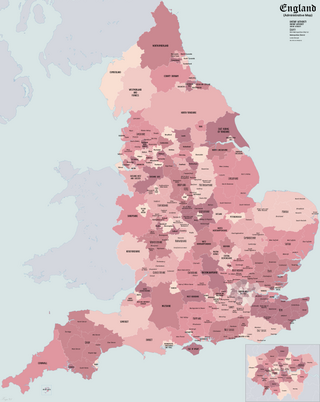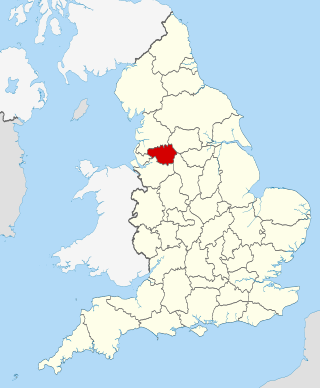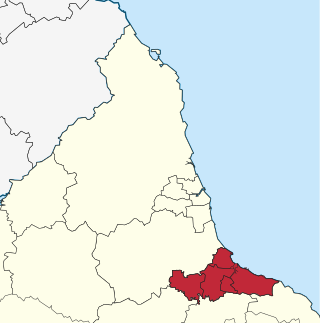Related Research Articles

Metropolitan counties are a subdivision of England which were originally used for local government. There are six metropolitan counties: Greater Manchester, Merseyside, South Yorkshire, Tyne and Wear, West Midlands and West Yorkshire.
Local government in Wales is primarily undertaken by the twenty-two principal councils. The councils are unitary authorities, meaning they are responsible for providing local government services within their principal area, including education, social work, environmental protection, and most highway maintenance. The principal areas are divided into communities, most of which have an elected community council. The services provided by community councils vary, but they will typically maintain public spaces and facilities. Local councils in Wales are elected; the most recent local elections in Wales took place in 2022, and the next are due to take place in 2027.

The subdivisions of England constitute a hierarchy of administrative divisions and non-administrative ceremonial areas.

The regional chambers of England were a group of indirectly elected regional bodies that were created by the provisions of the Regional Development Agencies Act 1998. There were eight regional chambers, one for each of the regions of England except Greater London, which had opted for an elected mayor and assembly in 1998. All eight regional chambers had adopted the title "regional assembly" or "assembly" as part of their name, though this was not an official status in law. The chambers were abolished over a two-year period between 31 March 2008 and 31 March 2010 and some of their functions were assumed by newly established local authority leaders' boards.

In the United Kingdom, regional development agencies (RDAs) were nine non-departmental public bodies established for the purpose of development, primarily economic, of England's Government Office regions between 1998 and 2010. There was one RDA for each of the NUTS level 1 regions of England. Similar activities were carried out in Wales by the Welsh Government Department of Economy and Transport, in Northern Ireland by the Department of Enterprise, Trade and Investment and in Scotland by Scottish Enterprise and Highlands and Islands Enterprise.

The Association of Greater Manchester Authorities was the local government association for Greater Manchester, a metropolitan county in North West England. Its creation followed the abolition of the Greater Manchester County Council, being established in 1986 as a governmental organisation to represent the ten district councils of Greater Manchester. AGMA was later superseded by the Greater Manchester Combined Authority, the first authority of this new type in the United Kingdom, on 1 April 2011.

South East England Regional Assembly (SEERA) was the regional chamber for the South East England region. Regional Chambers were established by the Regional Development Agencies Act 1998 and their function of consultation was shown in Section 8 of the Act. It was based at Guildford until it was dissolved on 31 March 2009, with its functions being assumed by the South East England Partnership Board, which comprises members of SEEDA board, the Regional Development Agency and the South East England Leaders’ Board, the executive body of South East England Councils.
In England, spatial planning is undertaken at the national level, through the National Planning Policy Framework. The London region is the only one to have a statutory London Plan. Most planning functions are exercised by local authorities, with neighbourhood planning also taking place in some areas.

Local authority leaders' boards are voluntary regional associations of council leaders that have been established in England outside of Greater London to replace certain functions of the now abolished regional chambers. The establishment of the boards was part of the UK Government's Review of Sub-National Economic Development and Regeneration. which brought forward the Government's plans to alter the structure of regional governance in England and was mandated by the Local Democracy, Economic Development and Construction Act 2009. In June 2010, the new Conservative-LibDem coalition government announced plans to remove funding from the new boards and to remove their statutory functions. It was indicated that the boards might continue as voluntary associations of council leaders.

The North East Regional Employers' Organisation, previously the Association of North East Councils is a partnership body made up of representatives of local authorities in North East England. It acts as the regional employers organisation.
South West Councils is an association of council leaders from the South West of England. It is a regional grouping of the Local Government Association and the regional employers organisation.

The regions of England, formerly known as the government office regions, are the highest tier of sub-national division in England. They were established in 1994 and follow the 1974–96 county borders. They are a continuation of the former 1940s standard regions which followed the 1889–1974 administrative county borders. Between 1994 and 2011, all nine regions had partly devolved functions; they no longer fulfil this role, continuing to be used for limited statistical purposes.

The Leeds City Region, or informally Greater Leeds, is a local enterprise partnership city region located in West Yorkshire, England. Prior to the West Yorkshire devolution deal, the partnership covered parts of South and North Yorkshire. According to the Office for National Statistics, as of 2017 the city region ranked 2nd behind Greater London for both population and GVA in the United Kingdom. It has a population of 2,320,214 million and a GVA of £69.62 billion.

A combined authority (CA) is a type of local government institution introduced in England outside Greater London by the Local Democracy, Economic Development and Construction Act 2009. CAs are created voluntarily and allow a group of local authorities to pool appropriate responsibility and receive certain devolved functions from central government in order to deliver transport and economic policy more effectively over a wider area. In areas where local government is two-tier, both must participate in the combined authority.
The East of England Local Government Association (EELGA) is an association of the 52 local authorities in the East of England. It is a regional grouping of the Local Government Association and the regional employers organisation. It was established in April 2010 following the abolition of the East of England Regional Assembly.

In England, local enterprise partnerships (LEPs) are voluntary partnerships between local authorities and businesses, set up in 2011 by the Department for Business, Innovation and Skills to help determine local economic priorities and lead economic growth and job creation within the local area. They carry out some of the functions previously carried out by the regional development agencies which were abolished in March 2012. In certain areas, funding is received from the UK government via growth deals.

The Liverpool City Region Combined Authority (LCRCA), officially the Halton, Knowsley, Liverpool, St Helens, Sefton and Wirral Combined Authority, is the combined authority of the Liverpool City Region in England. Its area includes the City of Liverpool local authority area, the Metropolitan Boroughs of Knowsley, St Helens, Sefton, and Wirral, and the Borough of Halton. It was established on 1 April 2014 by statutory instrument under the provisions of the Local Democracy, Economic Development and Construction Act 2009. Composition of the combined authority is made up of the leaders of the six principal membership authorities, plus several non-voting members with various vested interests in the activities of the combined authority.

The West Yorkshire Combined Authority (WYCA) is the combined authority for West Yorkshire in England. It was established by statutory instrument under the Local Democracy, Economic Development and Construction Act 2009 on 1 April 2014. It is a strategic authority with powers over transport, economic development and regeneration. The metro-mayor of the authority is Tracy Brabin.

The South Yorkshire Mayoral Combined Authority is the combined authority for South Yorkshire in England, with powers over transport, economic development and regeneration. It covers a total area of 3,484 km2 (1,345 sq mi) with a population of 1.8 million. The four metropolitan boroughs of South Yorkshire – Sheffield, Rotherham, Doncaster and Barnsley – are full members of the authority, while the Derbyshire Dales, North East Derbyshire, Chesterfield and Bolsover districts of Derbyshire, and the Bassetlaw district of Nottinghamshire, are non-constituent members.

The Tees Valley Combined Authority (TVCA) is the combined authority for the Tees Valley urban area in North East England consisting of the following five unitary authorities: Darlington, Hartlepool, Middlesbrough, Redcar and Cleveland, and Stockton-on-Tees, covering a population of approximately 700,000 people. It was proposed that a combined authority be established by statutory instrument under the Local Democracy, Economic Development and Construction Act 2009. It is a strategic authority with powers over transport, economic development and regeneration including the flagship Teesside Freeport.
References
- ↑ "Full Membership". Secouncils.gov.uk. Archived from the original on 14 August 2020. Retrieved 2014-05-06.
- ↑ "Previous structures". Secouncils.gov.uk. Archived from the original on 18 January 2021. Retrieved 2014-05-06.